WASTE MANAGEMENT





Understanding waste management Waste management explained
Let’s talk waste management
Your waste management action checklist Resources Climate Action guides

03 04 07 26 27 28
Fáilte Ireland's Climate Action Roadmap - Our Terms and Conditions of Use Disclaimer - Please note: this content is provided for information purposes only and Fáilte Ireland makes no representation or warranty, express or implied as to its accuracy, completeness, or suitability, or in relation to third party intellectual property rights in or to any part of the content.

Ireland has committed to cutting greenhouse gas emissions in half by 2030 and to achieving net-zero emissions by 2050. Driving Climate Action is a strategic priority for Fáilte Ireland, and we aim to help tourism businesses play their part in reducing greenhouse gas emissions.
Climate action has a major impact on the tourism and hospitality sector and together, we can work towards a more sustainable future.
Waste Management is a key climate action that helps reduce the carbon footprint of your business, and reducing waste is one of the simplest ways to reduce costs in your business.

The practical suggestions in this guide will lead to direct cost-savings. Look out for the money symbol on the right and remember, the less waste you generate, the less money you pay!
Let's get started.
THE ACTIONS IN THIS GUIDE CONTRIBUTE TO THE FOLLOWING SUSTAINABLE DEVELOPMENT GOALS (SDGS).

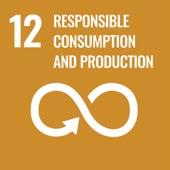


This useful Carbon Calculator can help you establish the carbon footprint of your business. Find out about the Climate Toolkit 4 Business here
Waste management is a key area for climate action, and by making small changes your business can save and become more sustainable at the same time. Here’s why waste management is an essential part of your climate action plan.

According to visitor research from booking.com, 84% of visitors want to reduce general waste. Examples include avoiding single-use toiletries (2021).
1 The resources we extract from the planet to produce goods are leading to global habitat loss, deforestation, greenhouse gas emissions, biodiversity loss and stress on water systems.
2 Less waste means less pollution and less greenhouse gas emissions.
3 Reducing food waste alone reduces emissions associated with farming, production, transportation, and preparation of food.
1 It reduces costs in your business Less waste leads to direct bottom-line savings for your business. Think about it – you pay twice when it comes to waste: you pay to buy the item and you pay to throw it away. In the case of food, you also pay for preparation and storage costs.
2 It makes your business more resilient We are in transition towards a low carbon society,
and this will shape our economy over the next decade. Adapting to this market change will help to build long-term business resilience.
3 It boosts your reputation Committing to waste management demonstrates that your business is playing its part to tackle climate change. In turn, this elevates your brand and reputation, boosting recruitment and enhancing marketing and sales.
Businesses are responsible for three types of emissions, referred to as Scope, 1, 2 and 3.

Scope 1: Greenhouse Gas Emissions your business produces directly e.g., through burning fossil fuels such as gas or oil to run your heating system.
Scope 2: Greenhouse Gas Emissions your business produces indirectly e.g., when you import electricity produced by power stations burning fossil fuel.
Scope 3: All the emissions not directly owned or controlled by your business, but that you are indirectly responsible for through your supply chain e.g., through the products you buy from suppliers such as food.
This guide includes actions relating to Scope 3.
4 Your clients, customers and staff expect it Customers, clients, and employees are now aware of the implications of climate change and are demanding greener options from business. Taking positive action to reduce waste will make your business more favourable in their eyes.

Your ability to report accurately and transparently on your successes in reducing waste in your business depends on how well you keep track of your key numbers. An easy way to do this is to create a spreadsheet to track waste but it’s essential that you keep it regularly updated. Take a snapshot of where you are
right now, before you start your waste management journey.
There are several different waste categories: general waste, food waste, dry recyclables, glass and more, all of which have different charges. Generally, waste is most costly while recyclables are the least so you
must consider each category separately. In this step, there are three recommended actions: log how much waste is generated and how much it costs establish your waste benchmark commit to regular monitoring

Your service provider should be able to give you these figures in spreadsheet format. If they cannot, consider working with a different service provider.
Most waste collection service providers log weight by waste type for each collection. Most also break down their charges by waste type and by collection on your monthly invoice. This means your invoice is a powerful source of data.
Ask your waste collection service provider to tell you how much
waste is collected annually from your business, with a breakdown of figures for each waste category in both cost and weight. This gives you an annual overview.

Create a tracking spreadsheet so that you can track weight and costs on a monthly basis thereafter. Separate out the different
categories of waste on your tracking spreadsheet and ensure you log both the weight for each category and the cost for each one. The three most important waste categories for you to consider are: general waste, food waste and recycled waste.
Calculate your waste benchmark
Benchmarking is an excellent method to track waste generation in your business over time. A benchmark allows you to track your own performance over time and to compare your business against others in the industry.
Once you have weight information for the different waste streams, calculate your waste benchmark. You can calculate the kg of waste per customer, per sleeper, per cover or per square metre, for example. This allows you to estimate how much
waste you are generating related to business activity. The amount of waste generated in your business right now is your first benchmark. Once you have established this, you can track your progress as you move forward on your climate journey.
TOTAL GENERAL WASTE PER YEAR
GENERAL WASTE BENCHMARK PER SLEEPERS
The most recent national benchmark for Irish hotel accommodation is 0.56kg general waste per sleeper (EPA, 2014).
There is no national benchmark for visitor attractions at present. You can still track against your own benchmark over time. For example, the Cliffs of Moher Visitor Experience set a target to reduce total waste to 50g per visitor in 2021.
Your waste collection bill tells you exactly how much waste your business is producing each month. Your bill should show a breakdown by waste category and the cost per category.
1 Study your bill and note the terminology that is used.
2 If you do not understand any item, contact your service provider for clarification.
3 If your bill does not show breakdown of weight and cost, request a full breakdown from your provider.
Your monthly waste bill is the key tool you need to stay informed on how much waste it takes to run your business. It is recommended that you monitor monthly as your bill arrives. This gives you detailed insights into
You can also look at the percentage of overall waste that you are sending for recycling (including mixed recyclables, cardboard, etc.) If your food waste is collected separately for composting, then consider this as recycled too.
In 2021, the Cliffs of Moher Visitor Experience recycled 57% of the waste collected from their site

the impact of the climate actions you are taking and how things change across the seasons.
Note any changes in weight or cost and enter the data into your spreadsheet. Once you’ve set up a tracking spreadsheet, it only takes a few minutes each month to keep it updated.
Once you have a good sense of how much waste is generated in your business, it’s time to get behind those figures and establish where the waste is coming from. Here are a few approaches that will help with that.
This could be a job for your Green Team, it’s a good idea to put one person in charge of this: pick a week for Bin Inspection Week check every bin twice a day for that week
list the two items that appear most often over the week and or at different points of the day
list any items that are in a bin that shouldn’t be e.g., food waste or cardboard in the general waste bin
Be methodical and note all findings systematically. This will give you clear, objective data that can help engage your team in your waste reduction project.
After one week, you’ll have solid information on which items are your key waste challenges. You’ll find out if staff and visitor behaviour relating to waste segregation is an issue. If it is, training and raising awareness would be a priority in your Improvement Action Plan. This task allows you to compare
waste activity across your business – if some areas are doing better than others, there may be learnings to share.
Where are your bins located? Are they easy for visitors and staff to access and do they have clear signage? Make this a team project and gather feedback from staff.
Is your waste collection area well maintained and is it easy to access all bins? If not, there may be a temptation to drop waste into the most convenient one, particularly in bad weather. Assess if the layout
“After we were logging data for a while, we really started to see the results – in black and white figures. This really encouraged us to keep going and take more actions that would make a difference.”
Sharon Malone, Sales & Marketing Manager Falls Hotel & Spa, Co. Clare
Falls Hotel & Spa, Co. Clare
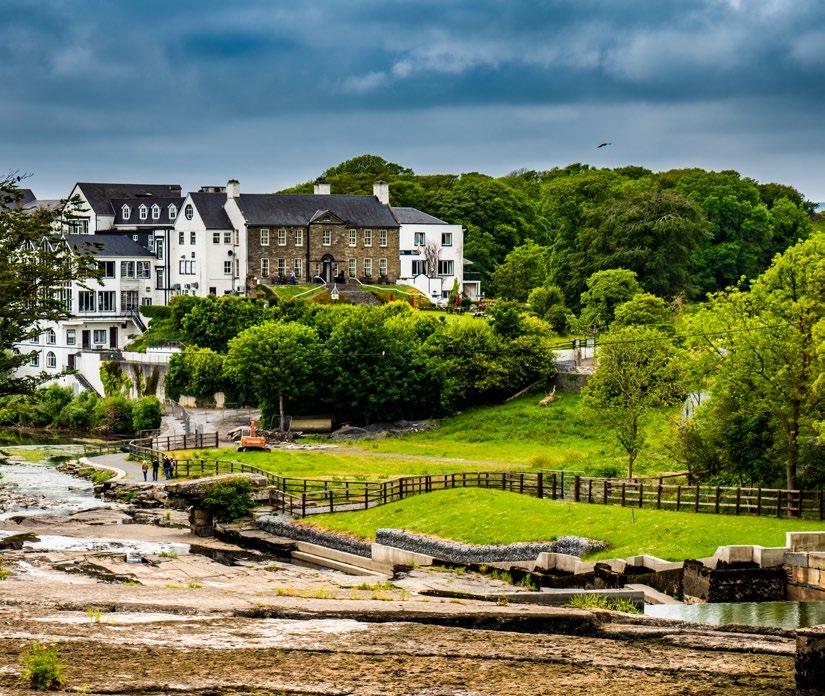
Reduce your pick-up costs (usually charged per bin) by ensuring bins are full to the top rather than having two or more bins that are each only partially full.
and signage of the bins are logical and whether it corresponds to the system in use in your buildings or on your site. Check if there is recyclable material in the general waste bin or vice versa.
If you find things are not quite as they should be, question what the reasons might be. Use this information to establish priorities in your Improvement Action Plan.
To understand what food waste arises in your business, carry out
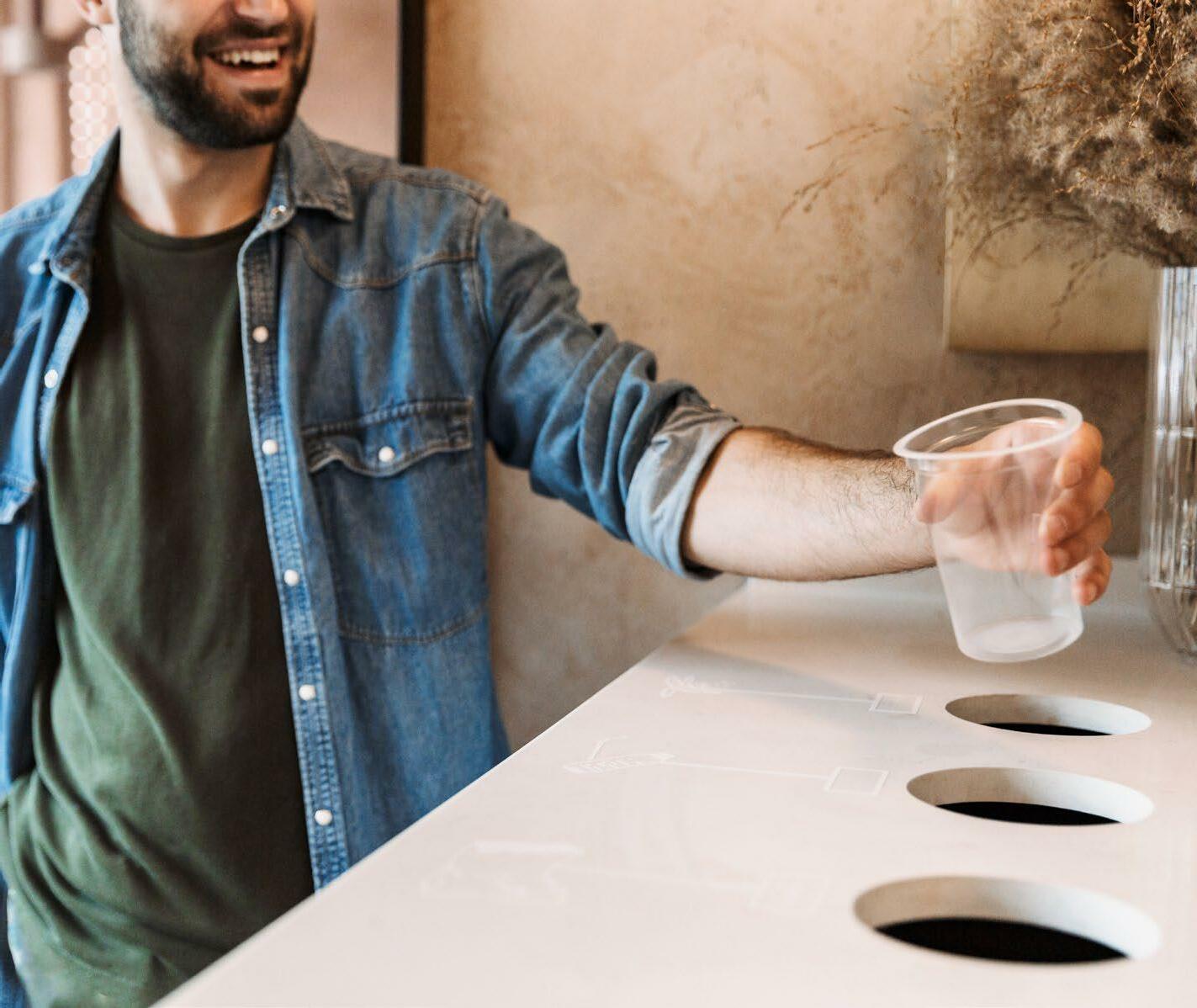
a Food Waste Survey for a day. This exercise will identify the main types of food waste arising, which will form your Improvement Action Plan priorities: choose a typical day of service assign a member of staff to weigh food waste arising survey for specific periods of time e.g., breakfast, lunchtime, dinner divide food waste into three containers: plate waste, preparation waste and unserved cooked food calculate your food waste per cover for each service
Once you have summarised your annual waste spend and how much you pay per kg/lift for each waste stream, shop around for a better price. Paying by weight is always preferable.
For larger businesses, consider using a waste management software platform that can collect, store and review data in a central location. These offer an alternative to spreadsheet tracking which can be useful to improve accuracy, prevent loss of data and provide real-time calculations.
Commit
Some items of prepared food may not be consumed by customers, this will vary menu by menu. Identify the main ones and implement actions to minimise them:
1 Pick a day of the week when the team has time to concentrate.
2 Place containers near your dishwashing or food disposal area and mark them clearly e.g., one for meat, one for
fish, one for vegetables, one for potatoes – to measure the main food waste types.
3 Task your team to weigh and record the main food wastes arising.
At the end of service, it will be very clear to everyone which items of food are most often returned.
The most common item returned is the first to address in the Improvement Action Plan.
Create a Food Spoilage Log – in a notebook or on a spreadsheet. Include the item, the weight and or amount, the date it was bought, the date it was binned and the reason for binning it.
Ask your chef to ensure that any item that has gone off in the fridge or stores is weighed and logged in the book before going into the bin. Use the information as an incentive for the whole team to minimise food waste.
This graph shows Irish benchmarks for five different types of food service industry. The benchmark is based on a combination of plate waste, preparation waste and unserved waste. If you are in one of these sectors comparing your food waste benchmark to these will indicate if you are better or worse than the average.
Once you understand where your waste is coming from and how people are dealing with waste in your business, then you can identify the priority areas for action. For businesses serving food, reducing food waste amounts is a priority area for reducing costs and reducing

greenhouse gas emissions. Your Green Team can put in place a standard review – evaluate revise model for waste and set team targets for reduction.
The priorities will be different for every business – in some cases, the waste challenge relates to
purchasing, business procedures are important for others, or staff and visitor awareness may be top of mind.
Check out the graphic on page 18 to understand the general order of priority of successful waste management.
The important thing is to set measurable goals and to assign a person and or team and deadline to each one. Here is a sample template for an Improvement Action Plan.
SAMPLE GOAL: Reduce food waste by 20% in one year
Actions to achieve this goal:
No. Action Who will do it? By when? Resources Required
“The first step is to start recording consumption of water, energy and waste. I recommend then setting a reduction target. Reducing these will mean a reduction in your costs while also being the right thing to do for the environment”.

Áine Martin, HR & Green Manager Hotel Doolin

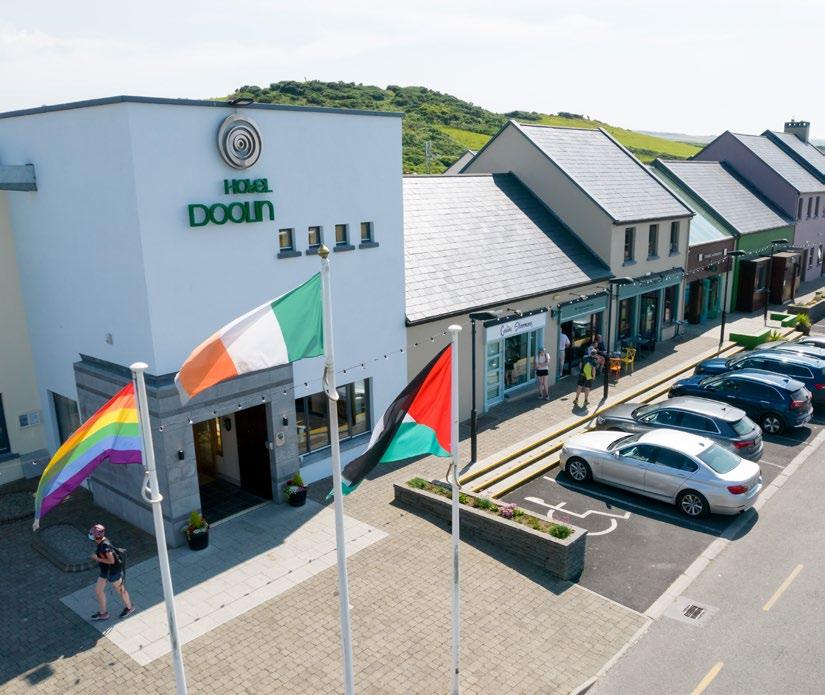
Find a fellow businessperson, a friend, or a family member to help you brainstorm solutions and work out an Improvement Action Plan.
The success of your Waste Management Plan depends on the people in your business. If you have been methodical about gathering data during the review stage, you will have great material to share with your team.
Gather your team and make an event of sharing the findings of your review and invite everyone in your business to brainstorm solutions for your biggest waste challenges.
Embedding sustainability into your culture stretches beyond encouraging employees to print less or recycle more. It’s about nurturing a long-term vision, mission and purpose that fosters a work environment where employees understand the impact of carbon emissions and are empowered to contribute towards change.

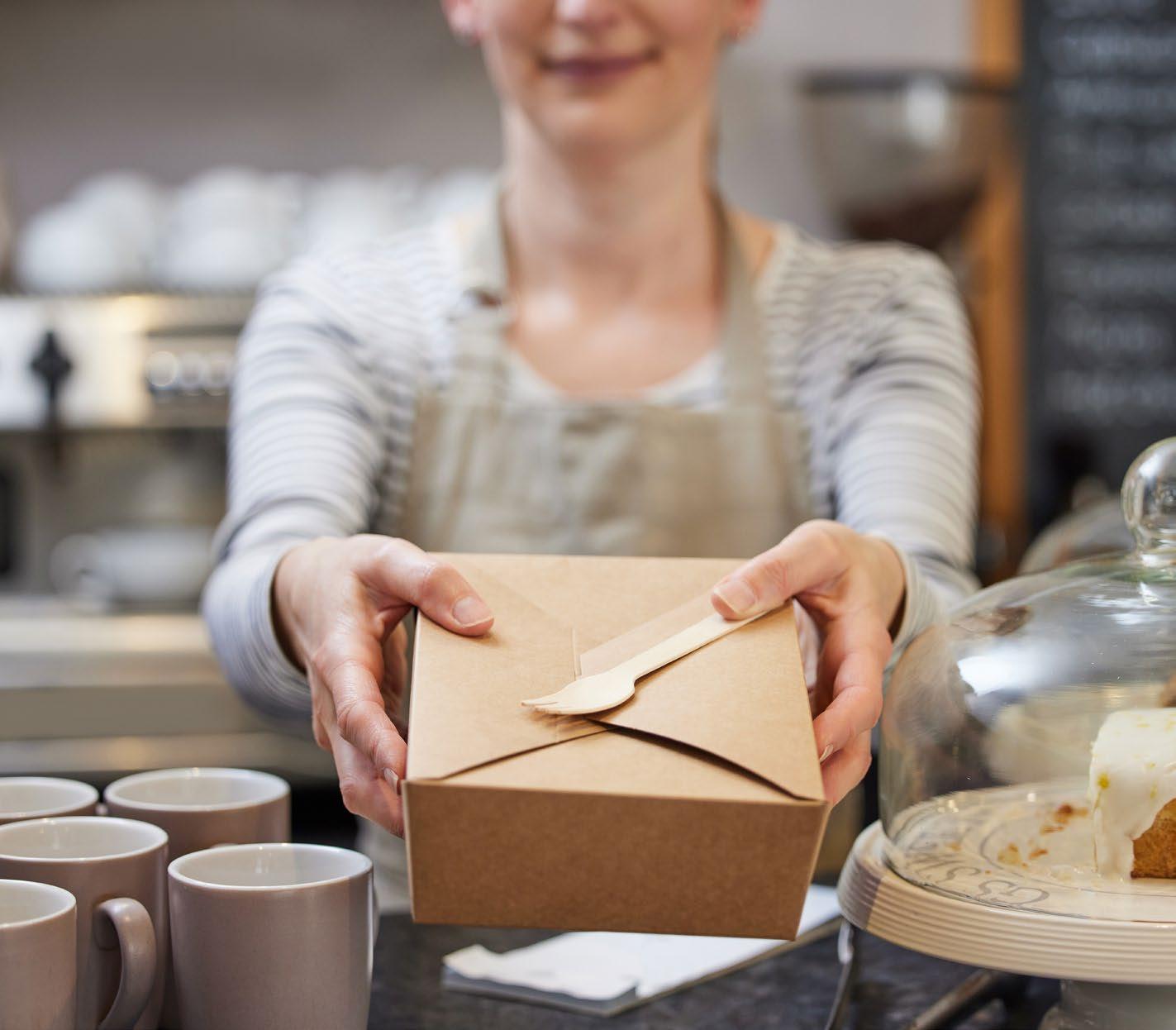
For more ideas to engage your team and sustain momentum, check out the How To Tell Your Climate Action Story guide.
Get a practical and systematic approach to reducing waste in your tourism business, across the six main waste areas. Check out this graphic to understand the general order of priority of successful waste management.
The absolute priority is to prevent waste coming into your business in the first place. The less waste that enters your business, the more you can save in terms of your carbon footprint and bottom-line costs:
make conscious decisions around your purchase of wasteful or non-recyclable products
discuss with suppliers how unnecessary product packaging can be eliminated
request re-usable or returnable containers
ensure all packaging supplied is recyclable factor the type and or quantity of packaging into discussions when negotiating new contracts. e.g., with linen suppliers
Identify all non-recyclable and wasteful products used in your business… just because you have always used an item doesn’t mean you need to continue doing so!
Ask yourself a couple of key questions:
how essential is this item in the running of our business or the delivery of the visitor experience?
are there alternatives to this product that we haven’t considered before?
Below are some common areas to tackle.
Public health considerations may mean some single use items cannot be eliminated but keep these under review and reduce where possible: TOILETRIES SAUCE SACHETS PLASTIC WATER BOTTLES PAPER PLATES PLASTIC CUTLERY WOODEN STIRRERS PLASTIC BIN LINERS LAUNDRY COVERS AND LAUNDRY BAGS Potential
Provide meeting delegates and event attendees with a reusable water bottle that can be refilled from a water station at the event
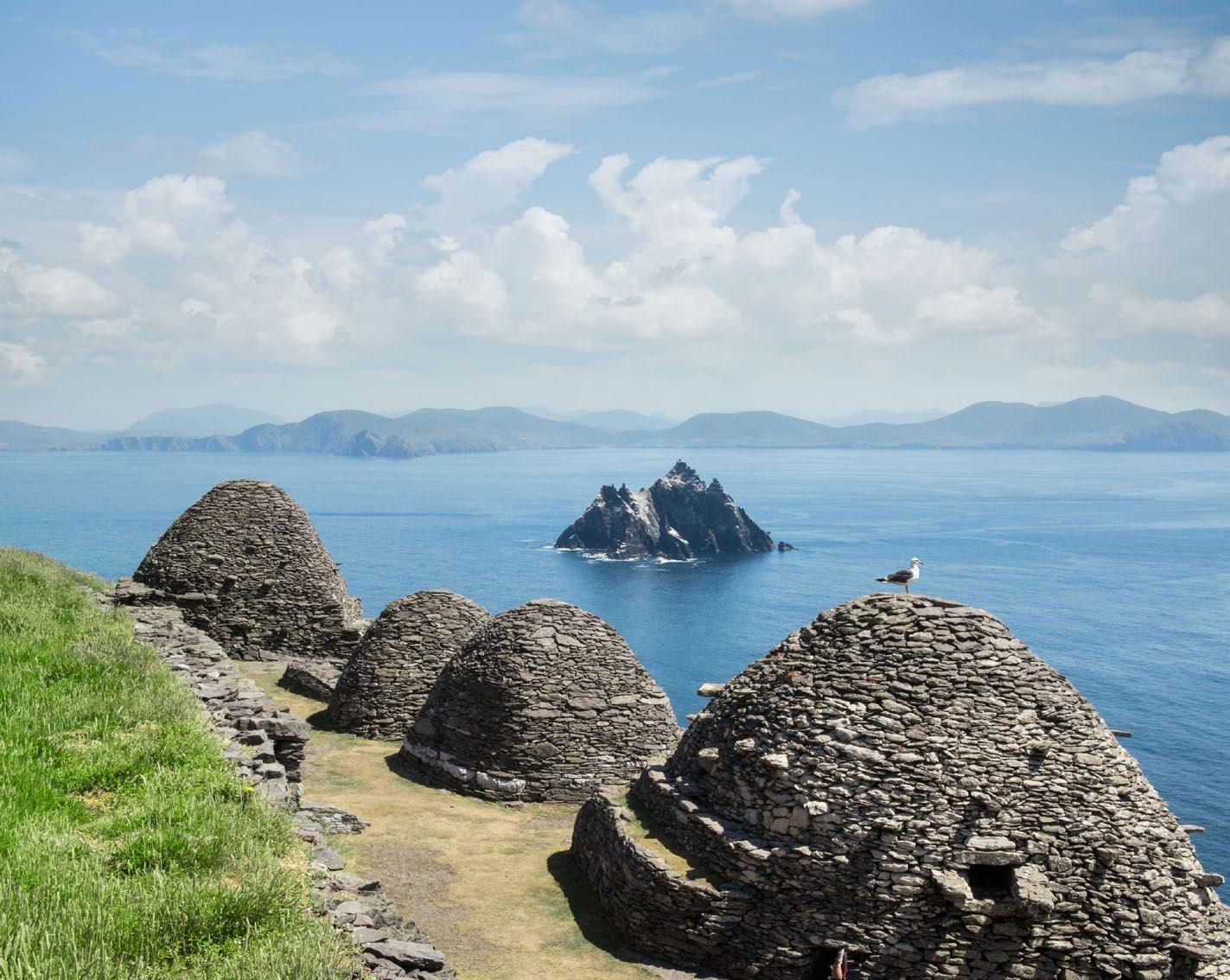
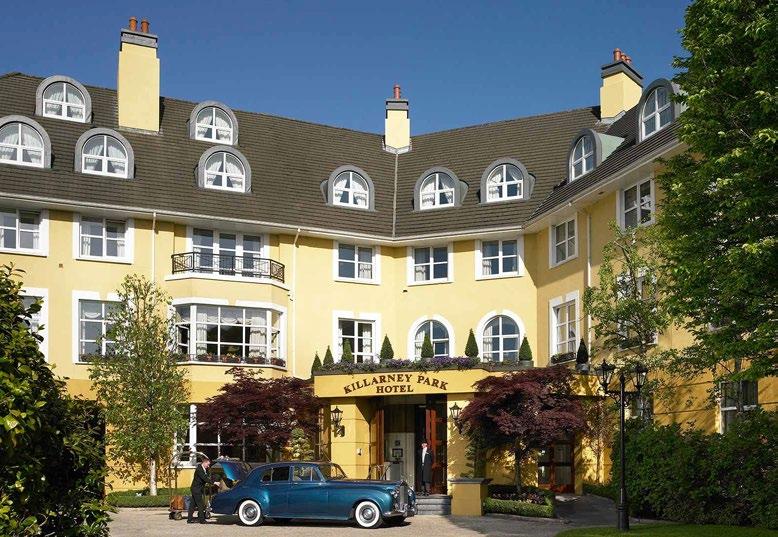
The Killarney Park Hotel decided to eliminate single-use toiletries in guest bathrooms and replace them with refillable containers. This resulted in a cost saving of €12,000 per annum. The hotel then collaborated with Clean the World to responsibly manage remaining toiletry waste.
Clean the World is a social enterprise that offers a soap and bottled amenity programme to hotels and other accommodation providers. Check it out: Hospitality Program Clean the World
Preventing food waste is the most favourable action to take when trying to manage food waste, so it’s important to start implementing these measures

Consider asking customers what portion size they want.
Offer free additional sides but only on request.
Serve bread from a main tray instead of placing a basket on the table.
Buffets typically result in more than twice as much food waste per customer (300 grams) than those served from a menu (130 grams)
(EPA 2019, Reducing Commercial Food Waste in Ireland.)
A business which overproduces just 5kg of food for breakfast, is throwing out over €5,000 per year worth of food, and this doesn’t even account for the costs to prepare or store this food.
Keep the range of perishable ingredients needed for your dishes to a minimum. Make sure the options, including sides and garnishes, are clear to avoid customers ending up with food they may not want.
If serving fewer tables with set dining times, consider the amounts that you prepare in each batch. It may be possible to reduce batch sizes and prevent wastage.
Stock rotation is an important thing to get right and there are three key principles here:
Label All food with dates received/dates cooked to identify what should be used first
Work to the ‘First in First Out Principle’ What comes in first, gets used first, food that needs to be used first should be at the front of your storage fridge
Get your team on board Make sure your team know how to reduce food waste and the part that stock rotation plays
Develop your Improvement Action Plan
Quantify your annual paper use, inhouse printing quantities and how much you spend on paper and printing. Once you know what your use and spend is, you can take steps to reduce it.
Think about:
team targets to reduce paper use measures to raise staff awareness
centralised printing management
default to double-sided printing
electronic means of communication
sustainable paper source online/contactless check-in and check-out
QR codes for menus and room information
Quantify how much promotional material you produce each year
and how much it costs. Look at quantities that remain unused at the end of the year. There is usually scope to reduce quantities and spend, start with the below measures.
order minimum quantities move more of your marketing activity online and onto social media platforms
use printing providers who can print on recycled paper and display the source of paper
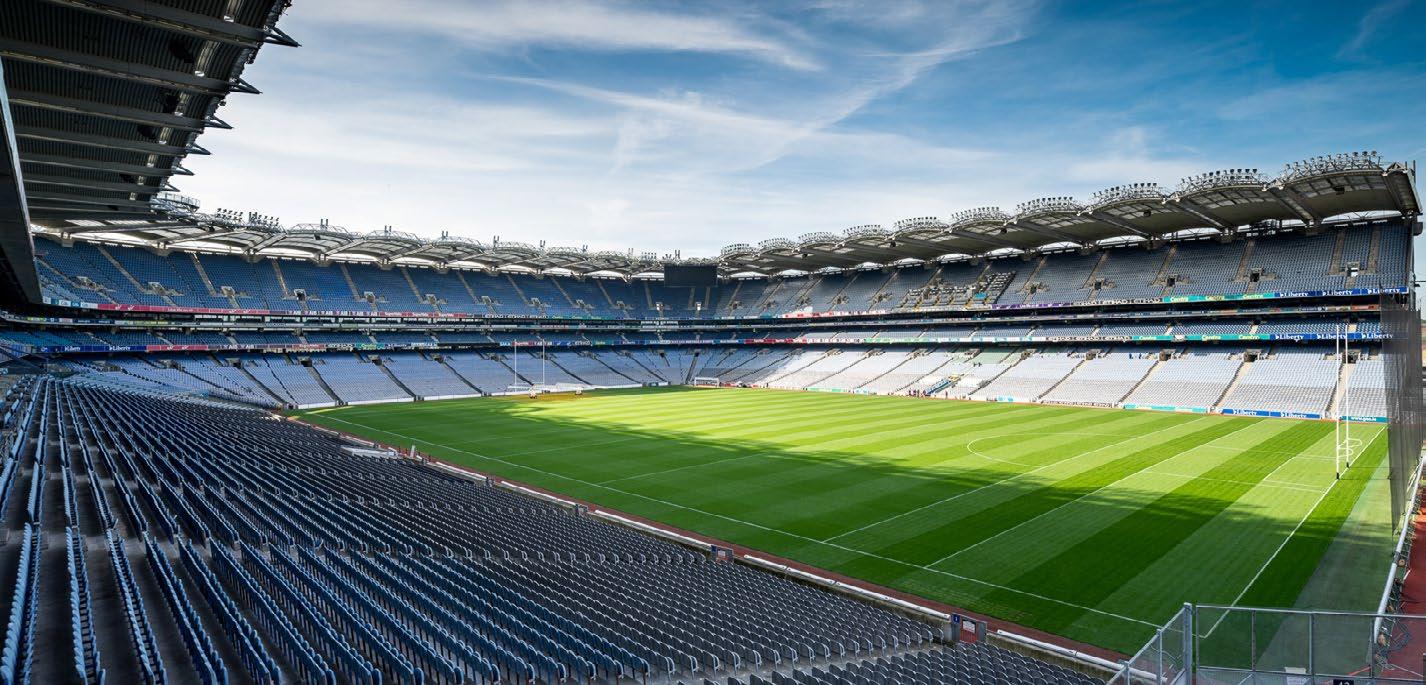
The Green Team at Croke Park set itself a target of zero waste to landfill, which it achieved in 2014. At meetings and events, the following actions help to reduce single-use waste: all event organisers are offered the option of a paperless meeting stationery is provided but not placed at each delegate seat, it’s available at a convenient central table which means that only those delegates who really need the stationery use it
Use sustainably sourced or recycled paper. Ensure paper carries the EU Eco-label, FSC or PEFC Label
all notepads are made of recyclable materials and pens are made from recycled cardboard still and sparkling water bottled in-house is provided
any single use cups and containers are 100% compostable bins are clearly labelled with what items go in which bin
Think about ways your business can easily reduce, reuse and repurpose waste items where possible.
See if items that can't be refused or reduced, could be re-purposed. Get creative and encourage your team to come up with cool upcycling ideas. Use cardboard
boxes for storing supplies, binder clips to hold power cords and chargers in place, and coffee mugs and tin cans for holding pens and pencils. You can donate old items and even excess fresh food.
To maintain an authentic and engaging visitor and or customer experience, The Shed Distillery, Drumshanbo, has invested in sustainable practices that benefit its customers and the environment.

The distilling process results in 700kg of waste spent grain per day i.e., grain which is left over after the mashing process. This is collected daily by local farmers and used as cattle feed.
In July 2021, the Shed Distillery invested in a shredder to shred in-coming cardboard used as packaging by suppliers. The shred is now used as protective packaging for The Shed’s e-commerce shipping, which eliminated the need for plastic bubble wrap.
The machine had paid for itself within six months and had saved 2,250m of bubble-wrap in that time.
Old suitcases and or trunks have been converted into furniture and seating pieces.
The slates used on the Shed Distillery Experience were reclaimed from the convent of The Poor Sisters of Claire in Drumshanbo, at the time the convent was being refurbished with new roof slates.
The Curious Laboratory of PJ Rigney is home to a repurposed laboratory cabinet previously house at Queens University, Belfast.
Roller-blackboards were reclaimed from local schools and now used as educational tools for visitors.
All waste that is diverted from landfill to recycling saves greenhouse gas emissions and saves costs for the business.
Charges to collect recycling waste are lower than those for general waste. In some cases, your waste contractor will collect recyclables for free because they have a commercial value.
1 Provide segregated bins Provide 3-bin systems to allow staff and customers segregate recyclables, food waste and general waste.
1 Place helpful signage on or near bins Ensure that bins are clearly labelled. Use self-
explanatory images rather than words.
3 Raise staff awareness Regularly train your team to give clear guidance of what waste goes in what bin.
These three actions save staff time, reduce mistakes, avoid confusion and frustration. They also reduce your waste bills.
Recent EPA research shows that up to 80% of general waste generated in the hospitality sector could be diverted into other bins. Waste disposable costs vary depending on the bin that materials end up in. It is important that staff are aware of, and trained, as to what waste goes in which bin.
1 Be clear about what waste goes where Specify this in your written procedures, make it clear in staff training and ensure bins are labelled correctly.
2 Ensure there are enough bins in the workspace to accommodate staff and that they are located conveniently to the workstation.
3 Ensure that the outdoor main waste area is well organised and that bins are labelled

identically to the bins located in-house.
4 Think about logistics and weather and make it easy for staff to choose segregation every time! Is the recycling bin further away than the general waste bin? Is the food waste bin in an unsheltered area so that, when it’s wet, it’s less appealing to walk out there?
5 Remove individual waste bins at desks and replace with centralised bins.
6 Use clear bags for general waste so it’s easier to see how well segregation is going.
7 Include all staff responsible for bringing waste to the outdoor main waste area in training.
8 Place clearly labelled recycling bins in guest bedrooms.
9 Introduce outdoor recycling bins, alongside your general outdoor litter bins.

For more ideas to engage your team and sustain momentum, check out the How To Tell Your Climate Action Story guide.
Composting diverts remaining food waste from landfill, which reduces greenhouse gas emissions and reduces business costs. By collecting food waste in your brown bins, you are preparing this food waste for composting.
As a last resort, materials that cannot be reused, recycled or repurposed must be landfilled and incinerated. This is the least preferable method of waste management because waste in landfill continues to cause carbon emissions and also generates air, soil, water, noise and odour pollution. The goal is to minimise the amount of waste your business sends to landfill, and ultimately to eliminate waste to landfill entirely.
Your clients, customers and community are aware of climate change and its impacts. Sharing your efforts to reduce waste, through social media, local press, and your own website, is a great way to engage with your stakeholders.
Your waste management action checklist
OPPORTUNITY
STEP 1 Understand waste generation and costs
Log and analyse the volume and cost of waste generated for each main waste category
COST
Low, Medium or High POTENTIAL FOR CARBON REDUCTIONS
Low, Medium or High
Low cost Low
Calculate your waste benchmarks for each main waste category Low cost Low
Commit to regular monthly monitoring Low cost Low
STEP 2 Understand where waste is coming from and how it is managed
Inspect bins and their contents
Low cost Low
Observe bin locations Low cost Low
Inspect your waste collection area
Low cost Low
Conduct a General Food Waste Survey Low cost Low
Conduct a Plate Waste Survey Low cost Low
Food Spoilage Patterns Low cost Low
STEP 3 Review data, evaluate and prioritise actions
Identify priority areas for attention and develop your Waste Improvement Action Plan Low cost Low
STEP 4 Implement strategies to reduce, reuse and recycle waste
Review packaging and speak with suppliers to prevent waste coming into your business
Reduce single-use items wherever possible
Reduce paper use and printing for day-to-day operations and for marketing materials
Manage and prevent food waste: customer communication, menu-planning, portion and batch sizes, stock rotation, labelling and staff training
Reuse and repurpose materials wherever possible
Commit to recycling. Improve waste segregation by setting up better systems, improving signage and providing training
Compost remaining food waste
Low cost Medium
Low cost Medium
Low cost Low to medium
Low cost Medium
Low cost Low
Low cost Medium
Low cost Medium
Check out these supports and resources to help you on your Climate Action journey.
Check out a comprehensive range of climate action and business supports and resources for the Irish tourism industry.

Find Out More
Find resource efficiency tools on the Environmental Protection Agency website Vist Website
03 MY WASTE
Learn how to manage waste in your business and get handy bin signage options. Learn More
04
Check out useful fact sheets and waste management resources to share with your staff. Get Facts
05
STOP FOOD WASTE
Get more information on how to calculate your food waste benchmark.
Calculate Benchmark
06
FOOD PODCAST
Check out of the Fáilte Ireland Inside Food Podcast Series. It’s all about reducing food waste! Listen to Podcast
Refill is a not-for-profit Irish organisation focused on eliminating the need for singleuse plastic bottles. Get ideas for branded reusable water bottles, water coolers, community hydration hubs and a zero wastewater solution for events.
Find Out More
Consciouscup.ie is notfor-profit organisation working to reduce and eventually eliminate single-use cups in Ireland, by encouraging cafés and other outlets to incentivise customers to bring their own. Don’t miss their great resources section.
Find Out More
Learn from Irish and international businesses about their Climate Action journey. Get inspiration and top tips.

Explore our series of guides as part of Fáilte Ireland’s Driving Action on Climate Change in tourism businesses. You can find links to all the others in the series to help you on your climate action journey here.


Explore our key tool designed to help you navigate the climate action journey of cost and carbon reduction.
Just click on the covers below to access each guide in our series.

Learn how minimising energy consumption using renewable energy alternatives will save costs and reduce carbon emissions.

Explore our guide for suggestions on how your business can reduce water consumption, resulting in a lower water bill.
Learn how to promote your Climate Action initiatives to the consumer.

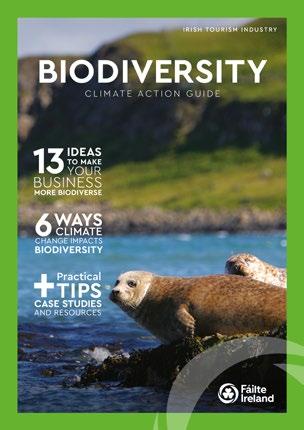
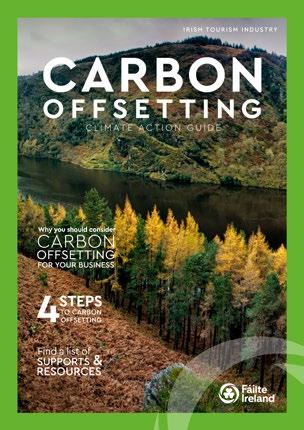
Read our advice for tourism businesses who wish to complement their reduction strategies by offsetting emissions.
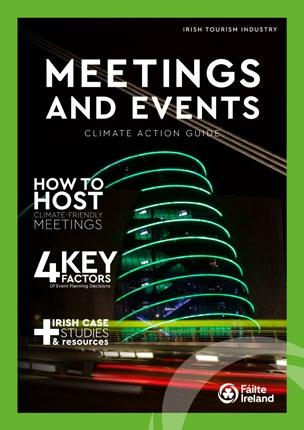
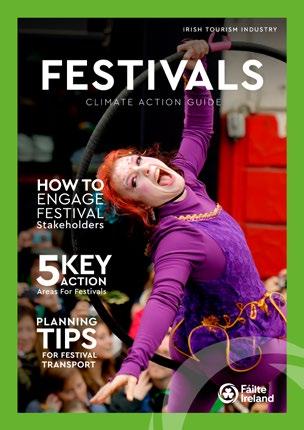
Find out how enhancing biodiversity in your business or location is a great place to start actioning climate change.
Learn how to run a climate-friendly meeting or event that incorporates environmental considerations.
Discover more about the importance of festivals for climate action from applying influence and inspiration to engaging with audiences.
